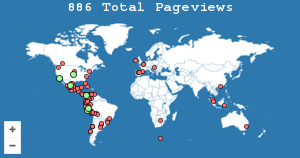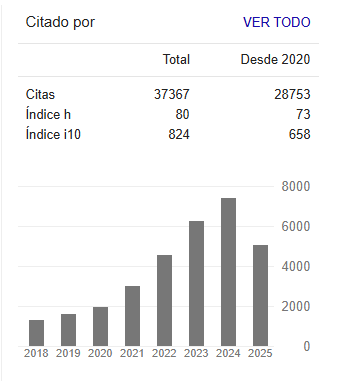Dimensiones de empleabilidad: una mirada de análisis bibliométrico
Resumen
Durante los últimos años, la empleabilidad ha proyectado una considerable transformación producto de cambios, los cuales han incidido en el mercado laboral; por consiguiente, este estudio propuso un análisis bibliométrico sobre la literatura existente sobre la empleabilidad. La revisión de literatura en Scopus reveló 13,567 publicaciones entre 1997 y 2023 en áreas de negocios, gestión y contabilidad, de las cuales 2,996 fueron relevantes. Al enfocar el análisis en “dimensiones de empleabilidad”, identifico 174 estudios, aplicando VOSviewer 1.16.18. Como resultado del análisis de contenido, los estudios sobre las dimensiones de empleabilidad mencionan la existencia de cinco dimensiones: experiencia ocupacional, anticipación y optimización, flexibilidad personal, sentido corporativo y equilibrio. Además, este estudio identificó una sexta y séptima dimensión explicativa: el manejo de segunda lengua y las competencias digitales. Como conclusión, se evidenció el creciente interés en las “dimensiones de empleabilidad” como un campo relevante dentro del ámbito laboral global, así como países, afiliaciones, autores, palabras clave y clústeres relevantes para el análisis de literatura existente sobre la empleabilidad y contribuir a futuros estudios empíricos en este campo.
Citas
Arntz, M., Gregory, T., & Zierahn, U. (2019). Digitization and the future of work: Macroeconomic consequences. In Handbook of labor, human resources and population economics (pp. 1-29). Cham: Springer International Publishing. https://doi.org/10.1007/978-3-319-57365-6_33-1
Ball, M. (2009). Learning, labour and employability. Studies in the Education of Adults, 41(1), 39-52. https://doi.org/10.1080/02660830.2009.11661548
Ballina Ríos, F., García Pérez de Lema, D., & Martínez García, F. J. (2015). La estrategia como factor determinante del rendimiento de la MIPYME: Un estudio empírico en México, DF. Revista de Estudios Empresariales, 2, 101-116.
Barrios, J., & Sáenz, J. (2020). Análisis de los factores para la empleabilidad en los profesionales de El Espinal Tolima. Revista Innova ITFIP, 6(1), 1-10. https://doi.org/10.35481/innova.v6i1.434
Bennett, R. (2002). Employers’ demands for personal transferable skills in graduates: A content analysis of 1,000 job advertisements and an associated empirical study. Journal of Vocational Education & Training, 54(4), 457-476. https://doi.org/10.1080/13636820200200191
Blanco-Ariza, A. B., Vásquez-García, Á. W., García-Jiménez, R., & Melamed-Varela, E. (2020). Estructura organizacional como determinante competitivo en pequeñas y medianas empresas del sector alimentos. Revista Latinoamericana de Administración, 56(2), 123-145. https://doi.org/10.1108/RLA-05-2020-0734
Boudreau, J. W., Boswell, W. R., & Judge, T. A. (2001). Effects of personality on executive career success in the United States and Europe. Journal of Vocational Behavior, 58(1), 53–81. https://doi.org/10.1006/jvbe.2000.1755Brown, P., Green, A., & Lauder, H. (2001). High skills: Globalization, competitiveness, and skill formation: globalization, competitiveness, and skill formation. OUP Oxford.
Brown, P., Green, A., & Lauder, H. (2001). High skills: Globalization, competitiveness, and skill formation: globalization, competitiveness, and skill formation. OUP Oxford.
Caballero, G., López-Miguens, M., & Lampón, J. (2014). La universidad y su implicación con la empleabilidad de sus graduados. Revista Española de Investigaciones Sociológicas, 146(146), 23-46. https://doi.org/10.5477/cis/reis.146.23
Cattaneo, A. A., Antonietti, C., & Rauseo, M. (2022). How digitalised are vocational teachers? Assessing digital competence in vocational education and looking at its underlying factors. Computers & Education, 176, 104358. https://doi.org/10.1016/j.compedu.2022.104358
Cerrato, K., Argueta, L., & Zavala, J. (2016). Determinantes de la empleabilidad en el mercado laboral. Revista de Métodos Cuantitativos para la Economía y la Empresa, 7(1), 21-40. https://www.lamjol.info/index.php/EyA/article/view/4292/4034
Chamorro-Premuzic, T., & Furnham, A. (2010). The psychology of personnel selection. Cambridge University Press.
Chapman, G. M., & Martin, J. F. (1995). Computerized business games in engineering education. Computers & Education, 25(1-2), 67-73. https://doi.org/10.1016/0360-1315(95)00002-7
Collet, C., Hine, D., & Du Plessis, K. (2015). Employability skills: Perspectives from a knowledge-intensive industry. Education and Training, 57(5), 532-559. https://doi.org/10.1108/ET-07-2014-0076
Crook, T. R., Todd, S. Y., Combs, J. G., Woehr, D. J., & Ketchen, D. J., Jr. (2011). Does human capital matter? A meta-analysis of the relationship between human capital and firm performance. Journal of Applied Psychology, 96(3), 443–456. https://doi.org/10.1037/a0022147
Das, S. K. M., & Velmurugan, R. (2019). Skill for employability among MBA students, the gap between skill and employability: A study conducted among MBA students and employers. Journal of Advanced Research in Dynamical & Control Systems, 11(7), 1-7.
David-López, G. P. (2022). Impacto social de la Cuarta Revolución Industrial y la responsabilidad social empresarial como respuesta. I+D Revista de Investigaciones, 17(2), 121-130.
Donthu, N., Gremler, D. D., Kumar, S., & Pattnaik, D. (2021). Mapping service journal research topics: A review of 22 years. Journal of Service Research, 23(2), 187–193. https://doi.org/10.1177/1094670520977672
Drucker, P. F. (1999). Knowledge-worker productivity: The biggest challenge. California Management Review, 41(2), 79-94. https://doi.org/10.2307/41165987
East, M., & Slomp, D. (2023). The ethical turn in writing assessment: How far have we come, and where do we still need to go? Language Teaching, 1-12. https://doi.org/10.1017/S0261444823000012
Finch, D. J., Peacock, M., Levallet, N., & Foster, W. (2016). A dynamic capabilities view of employability: Exploring the drivers of competitive advantage for university graduates. Education + Training, 58(1), 61–81. https://doi.org/10.1108/ET-02-2015-0013
Forrier, A., Verbruggen, M., & De Cuyper, N. (2015). Integrating different notions of employability in a dynamic chain: The relationship between job transitions, movement capital and perceived employability. Journal of Vocational Behavior, 89, 56–64. https://doi.org/10.1016/j.jvb.2015.04.007
Fugate, M., & Kinicki, A. J. (2006). A dispositional approach to employability: Development of a measure and test of implications for employee reactions to organizational change. Journal of Occupational and Organizational Psychology, 81, 503–527. https://doi.org/10.1348/096317906X159728
Gibb, S. (2014). Soft skills assessment: Theory development and the research agenda. International Journal of Lifelong Education, 33(4), 455-471. https://doi.org/10.1080/02601370.2013.867546
Grant, A. M., & Ashford, S. J. (2008). The dynamics of proactivity at work. Research in Organizational Behavior, 28, 3-34. https://doi.org/10.1016/j.riob.2008.04.002
Greenland, S., Saleem, M., Misra, R., & Mason, J. (2022). Sustainable management education and an empirical five-pillar model of sustainability. The International Journal of Management Education, 20(3), 100658. https://doi.org/10.1016/j.ijme.2022.100658
Guilbert, L., Bernaud, J. L., Gouvernet, B., & Rossier, J. (2016). Employability: Review and research prospects. International Journal for Educational and Vocational Guidance, 16, 69-89. https://doi.org/10.1007/s10775-015-9288-4
Hillage, J., & Pollard, E. (1998). Employability: Developing a framework for policy analysis (Vol. 107). DfEE.
Holopainen, M., Saunila, M., & Ukko, J. (2023). Value creation paths of organizations undergoing digital transformation. Knowledge and Process Management, 30(2), 125-136. https://doi.org/10.1002/kpm.1683
Kluytmans, F., & Ott, M. (1999). Management of employability in the Netherlands. European Journal of Work and Organizational Psychology, 8(2), 261-272. https://doi.org/10.1080/135943299398110
Korsen, E. B. H., & Ingvaldsen, J. A. (2022). Digitalisation and the performance measurement and management system: Reinforcing empowerment. International Journal of Productivity and Performance Management, 71(4), 1059-1075. https://doi.org/10.1108/IJPPM-12-2020-0663
Lantarón, B. S. (2016). Empleabilidad: Análisis del concepto. Revista de Investigación en Educación, 14(1), 67-84.
Leslie, D., & Russell, H. D. (2006). The importance of foreign language skills in the tourism sector: A comparative study of student perceptions in the UK and continental Europe. Tourism Management, 27(6), 1397-1407. https://doi.org/10.1016/j.tourman.2005.12.016
Madero, S. M., & Barboza, G. A. (2015). Interrelationship of culture, labor flexibility, strategic alignment, innovation and firm performance. Contaduría y Administración, 60(4), 735-756. https://doi.org/10.1016/j.cya.2015.06.003
Mahalawat, V., & Sharma, B. (2019). Study of factors affecting employee satisfaction and their impact on the organization. Journal of Xi’an University of Architecture & Technology, 11, 939-945.
McClelland, D. C. (1973). Testing for competence rather than for “intelligence”. American Psychologist, 28(1), 1-14. https://doi.org/10.1037/h0034092
Mertens, L. (1996). Competencia laboral: Sistemas, surgimiento y modelos. México: Editorial Cinterfor.
Ocaña-Fernández, Y., Valenzuela-Fernández, L. A., & Garro-Aburto, L. L. (2019). Artificial intelligence and its implications in higher education. Journal of Educational Psychology-Propositos y Representaciones, 7(2), 553-568. https://doi.org/10.20511/pyr2019.v7n2.278
Onstenk, J. H. A. M., & Kessels, J. (1999). Employability: Arbeidsmarkt, brede vakbekwaamheid en burgerschap. Comenius, 19, 113–132.
Pellegrino, J. W., & Hilton, M. L. (2012). Education for life and work: Developing knowledge and skills transferable in the 21st century. Washington, DC: National Academies Press.
Podsakoff, P. M., MacKenzie, S. B., Paine, J. B., & Bachrach, D. G. (2000). Organizational citizenship behaviors: A critical review of the theoretical and empirical literature and suggestions for future research. Journal of Management, 26(3), 513-563. https://doi.org/10.1177/014920630002600307
Rangel, A., & Peñalosa, E. A. (2013). Alfabetización digital en docentes de educación superior: Construcción y prueba empírica de un instrumento de evaluación. Píxel-Bit: Revista de Medios y Educación, 43, 75-88.
Ratten, V., & Jones, P. (2021). Entrepreneurship and management education: Exploring trends and gaps. International Journal of Management Education, 19(1), 100431. https://doi.org/10.1016/j.ijme.2021.100431
Rentería, E. (2008). Empregabilidade: Versões e implicações. Uma leitura desde a psicologia social. [Tesis doctoral, Universidad de São Paulo]. https://www.teses.usp.br/teses/disponiveis/47/47134/tde-12022009-143157/pt-br.php
Richardson, N. (2019). Corporate social responsibility or sustainability in music festivals. International Journal of Organizational Analysis, 27(5), 1257-1273. https://doi.org/10.1108/IJOA-01-2019-1632
Rothwell, A., Herbert, I., & Rothwell, F. (2008). Self-perceived employability: Construction and initial validation of a scale for university students. Journal of Vocational Behavior, 73, 1–12. https://doi.org/10.1016/j.jvb.2007.12.001
Salahodjaev, R., & Otajonov, S. (2021, December). The role of innovation in social progress? An empirical exploration. In The 5th International Conference on Future Networks & Distributed Systems (pp. 398-400).
Sarassa, J. B., & Pérez, E. R. (2019). Empleabilidad y trabajo del profesorado universitario: Una revisión del campo. Athenea Digital: Revista de Pensamiento e Investigación Social, 19(3), 1-27. https://doi.org/10.5565/rev/athenea.2405
Savickas, M. L., Nota, L., Rossier, J., Dauwalder, J. P., Duarte, M. E., Guichard, J., ... & Van Vianen, A. E. (2009). Life designing: A paradigm for career construction in the 21st century. Journal of Vocational Behavior, 75(3), 239-250. https://doi.org/10.1016/j.jvb.2009.04.004
Singer, L. M., & Alexander, P. A. (2017). Reading on paper and digitally: What the past decades of empirical research reveal. Review of Educational Research, 87(6), 1007-1041. https://doi.org/10.3102/0034654317722961
Skinner, E. A. (1996). A guide to constructs of control. Journal of Personality and Social Psychology, 71(3), 549-570. https://doi.org/10.1037/0022-3514.71.3.549
Spinosa, M. A. A. (2005). From employment to employability, from education to educability: Conceptual mutations and individualization of social conflicts. Recuperado de http://www.aset.org.ar/congresos/7/10003.pdf
Stanton, S. (2021). Inglés para el empleo: El aprendizaje del inglés en la educación técnica y la formación profesional. [Libro].
Suárez, B. (2016). Empleabilidad: Análisis del concepto. Revista de Investigación en Educación, 14(1), 67-84. https://revistas.uvigo.es/index.php/reined/article/view/2066/2030
Thijssen, J. G., Van der Heijden, B. I. J. M., & Rocco, T. S. (2008). Toward the employability–link model: Current employment transition to future employment perspectives. Human Resource Development Review, 7(2), 165-183. https://doi.org/10.1177/1534484308314955
Van Deursen, A. J., & Van Dijk, J. A. (2014). The digital divide shifts to differences in usage. New Media & Society, 16(3), 507-526. https://doi.org/10.1177/1461444813487959
Van der Heijde, C. M., & Van der Heijden, B. I. J. M. (2006). A competence-based and multidimensional operationalization and measurement of employability. Human Resource Management, 45(3), 449–476. https://doi.org/10.1002/hrm.20119
Van Der Heijden, B., Notelaers, G., Peters, P., Stoffers, J., De Lange, A., Froehlich, D. E., & Van der Heijde, C. M. (2018). Development and validation of the short form of employability of five factor instrument. Journal of Vocational Behavior, 106, 236-248. https://doi.org/10.1016/j.jvb.2018.02.003
Van der Krogt, F. J. (1998). Learning network theory: The tension between learning systems and work systems in organizations. Human Resource Development Quarterly, 9, 157–177.
Van Eck, N. J., & Waltman, L. (2022). Crossref as a source of open bibliographic metadata. Scientometrics, 125(1), 281-298. https://doi.org/10.1007/s11192-022-04312-5
Zhao, Y., Sánchez Gómez, M. C., Pinto Llorente, A. M., & Zhao, L. (2021). Digital competence in higher education: Students’ perception and personal factors. Sustainability, 13(21), 12184. https://doi.org/10.3390/su132112184

Esta obra está bajo licencia internacional Creative Commons Reconocimiento-NoComercial-CompartirIgual 4.0.








.png)






























